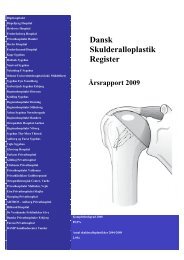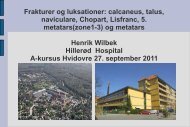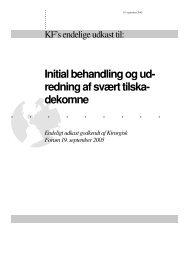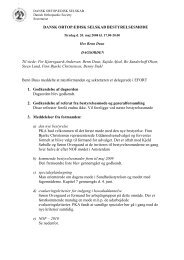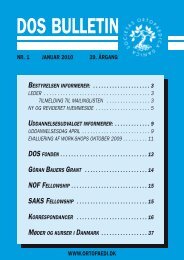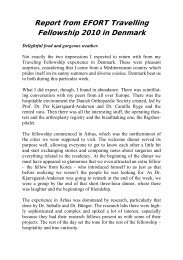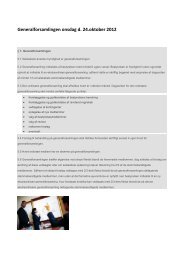DOS BULLETIN - Dansk Ortopædisk Selskab
DOS BULLETIN - Dansk Ortopædisk Selskab
DOS BULLETIN - Dansk Ortopædisk Selskab
Create successful ePaper yourself
Turn your PDF publications into a flip-book with our unique Google optimized e-Paper software.
2010-378_<strong>DOS</strong> nr. 3 2010 29/09/10 10:08 Side 111<br />
Effect of standing position and weight-bearing on<br />
joint space width and pelvic tilt in radiographs of<br />
patients with dysplasia of the hip<br />
Anna Katrine Sundgaard, Maria Grevit, Trine Torfing,<br />
Ole Ovesen, Søren Overgaard<br />
Department of Orthopaedic Surgery and Traumatology, Odense University<br />
Hospital; Department of Radiology, Odense University Hospital<br />
Background: It is generally accepted that the radiographs of the hip are<br />
taken in supine position. It is of interest how radiographic measures differ<br />
in patients with hip dysplasia when changing positioned from supine<br />
to standing knowing that the patient’s functional problem mostly occurs<br />
during weight-bearing.<br />
Purpose: The primary aim of the present study was to determine if<br />
pelvic tilt (represented by the distance between the symphysis and the<br />
sacrococcygeal joint), center edge angle, acetabular index angle, joint<br />
space width, approximated acetabular index of depth to width, femoral<br />
head coverage, posterior wall sign, and cross-over sign differ between<br />
supine and standing weight-bearing position in patients with hip dysplasia.<br />
The secondary aim was to estimate interobserver agreement.<br />
Methods: 23 patients with clinically diagnosed hip dysplasia from the<br />
waiting list for periacetabular osteotomy were included and had supine<br />
and standing weight-bearing standardized anteroposterior pelvic radiographs.<br />
Two readers independently assessed all the radiographs.<br />
Findings: The distance between the symphysis and the sacrococcygeal<br />
joint and center edger angle were reduced in females and males, respectively.<br />
Acetabular index angle increased overall. Minimum joint space<br />
width increased in females. We found no change in acetabular index of<br />
depth to width and femoral head coverage. Posterior wall sign increased<br />
and cross-over sign decreased in the females.<br />
Conclusion: Several of our key-measures changed significantly from<br />
supine to standing position and especially those for evaluation of acetabular<br />
version.Preoperative planning of surgery for reorientation of a retroverted<br />
acetabulum has to be done on both supine and standing weightbearing<br />
radiographs of the pelvis.<br />
111





